BARBERRY (Berberis vulgaris)
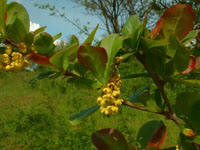 Antiseptic. Useful as gargle and mouthwash. Used in inflammatory conditions. Helps remove morbid matter from the stomach and bowels. Used for correcting liver function. Promotes flow of bile. Has been shown to reduce an enlarged spleen. Aids gallbladder. Stimulates flow of bile from liver to gallbladder. Same class as goldenseal for use as natural antibiotic. Contains berberine. Avoid during pregnancy.
Antiseptic. Useful as gargle and mouthwash. Used in inflammatory conditions. Helps remove morbid matter from the stomach and bowels. Used for correcting liver function. Promotes flow of bile. Has been shown to reduce an enlarged spleen. Aids gallbladder. Stimulates flow of bile from liver to gallbladder. Same class as goldenseal for use as natural antibiotic. Contains berberine. Avoid during pregnancy.
Key Uses: diarrhea, indigestion, jaundice, liver problems, gallbladder problems, sore throat. Useful for mucus membrane infections, ulcers, sinus infections and as a vaginal douche.
BARLEY GRASS (Hordeum vulgare)
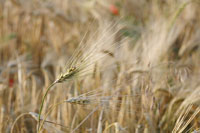 Contains concentrated nutrients, enzymes, chlorophyll, proteins, vitamins and minerals. Possesses anti-viral properties. Immune system enhancer. Has shown possible anti-tumor activity.
Contains concentrated nutrients, enzymes, chlorophyll, proteins, vitamins and minerals. Possesses anti-viral properties. Immune system enhancer. Has shown possible anti-tumor activity.
Key Uses: anemia, arthritis, blood purifier, boils, cancer, metal poisoning.
BAYBERRY (Myrica cerifera)
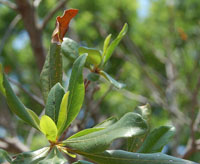 Antiseptic. Used as gargle for tonsillitis and sore throat. Used for colds, flu, fevers as a stimulant to rally the body’s defenses. Astringent for hemorrhoids and vaginal discharge. Excellent for colds and flu. A component of the famous, “Dr. Thompson’s Composition Powder.”
Antiseptic. Used as gargle for tonsillitis and sore throat. Used for colds, flu, fevers as a stimulant to rally the body’s defenses. Astringent for hemorrhoids and vaginal discharge. Excellent for colds and flu. A component of the famous, “Dr. Thompson’s Composition Powder.”
Key Uses: cholera, diarrhea, dysentery, glands, goiter, indigestion, jaundice, excessive menstrual bleeding, scrofula, uterine hemorrhage.
BILBERRY (Vaccinium myrtillus)
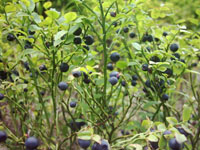 Possesses significant collagen-stabilizing action. Has the ability to cross-link collagen fibers. Reduces free radical damage as an antioxidant. Inhibits enzymatic cleavage of collagen by enzymes secreted during inflammation. Hinders the release of compounds that promote inflammation. Decreases capillary fragility and permeability. Decreases the permeability of the blood-brain barrier. Anti-aggregation effect on platelets. Reduces hyperglycemia. Smooth muscle relaxer. Anti-ulcer activity. Has been used to treat cataracts, vascular disorders, peptic ulcers, diabetes, mitral valve prolapse.
Possesses significant collagen-stabilizing action. Has the ability to cross-link collagen fibers. Reduces free radical damage as an antioxidant. Inhibits enzymatic cleavage of collagen by enzymes secreted during inflammation. Hinders the release of compounds that promote inflammation. Decreases capillary fragility and permeability. Decreases the permeability of the blood-brain barrier. Anti-aggregation effect on platelets. Reduces hyperglycemia. Smooth muscle relaxer. Anti-ulcer activity. Has been used to treat cataracts, vascular disorders, peptic ulcers, diabetes, mitral valve prolapse.
Key Uses: diabetic retinopathy, macular degeneration, cataract, glaucoma, varicose veins, Reynard’s Syndrome. Useful for diarrhea. Powerful antioxidant. Used for most disorders of the eye.
BLACK COHOSH (Cimicifuga racemosaa)
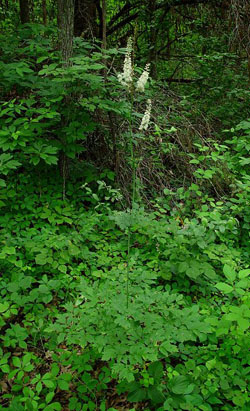 Has ben used for nervous conditions. Known to relieve nerve pains, numbness and neuralgia. Emmenagogue. Known to relieve menstrual pains. Menopause. Contracts uterus. Helps increases circulation to reproductive organs. Helps expel mucus from bronchial tubes. Contains phytoestrogens. Should not be used during pregnancy. Should not be used if diagnosis of breast or other reproductive organ cancers are apparent. Should not be used in cases of fibrocystic breast disease. Traditionally used about week before delivery to facilitate birth. It is a hypoglycemic. Aids in reducing hypertension. Large dosages can cause nausea and dizziness. Can provoke miscarriage.
Has ben used for nervous conditions. Known to relieve nerve pains, numbness and neuralgia. Emmenagogue. Known to relieve menstrual pains. Menopause. Contracts uterus. Helps increases circulation to reproductive organs. Helps expel mucus from bronchial tubes. Contains phytoestrogens. Should not be used during pregnancy. Should not be used if diagnosis of breast or other reproductive organ cancers are apparent. Should not be used in cases of fibrocystic breast disease. Traditionally used about week before delivery to facilitate birth. It is a hypoglycemic. Aids in reducing hypertension. Large dosages can cause nausea and dizziness. Can provoke miscarriage.
Key Uses: asthma, bronchitis, epilepsy, high blood pressure, hormone balance, menopause, menstrual problems, St. Vitus Dance, tuberculosis, whooping cough.
BLACK WALNUT (Juglans nigra)
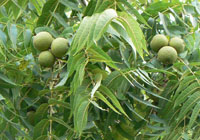 Effective against nephritis, bladder inflammation, cardiac degeneration, obesity, thyroid problems, and menstrual problems. Used in weight loss formulas. Helps lower blood cholesterol levels. Shown to stimulate sluggish thyroid. Protects the stomach.
Effective against nephritis, bladder inflammation, cardiac degeneration, obesity, thyroid problems, and menstrual problems. Used in weight loss formulas. Helps lower blood cholesterol levels. Shown to stimulate sluggish thyroid. Protects the stomach.
Key Uses: hypothyroidism, goiter, obesity, rheumatoid arthritis, inflamed joints.
BLESSED THISTLE (Cnicus benedictus)
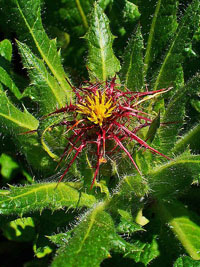 Used for stomach and liver. Increases mother’s milk. Reduces liver congestion. Increases appetite. Used to treat hepatitis and jaundice. Especially useful as a digestive aid. Helps balance hormones. Extremely bitter. Possible anti-tumor activity. Aids circulation. Has some anti-anxiety effects. Relieves melancholy.
Used for stomach and liver. Increases mother’s milk. Reduces liver congestion. Increases appetite. Used to treat hepatitis and jaundice. Especially useful as a digestive aid. Helps balance hormones. Extremely bitter. Possible anti-tumor activity. Aids circulation. Has some anti-anxiety effects. Relieves melancholy.
Key Uses: blood circulation, blood purifier, digestion, gall bladder, headaches, balances hormones, lactation, liver ailments, lungs, menstrual problems.
BLOODROOT (Sanguinaria candensis)
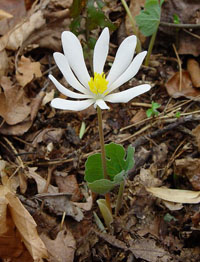 On the endangered or threatened species lists in some states. Rhizome, leaf and stalk contain a reddish-orange juice. Native Americans used this juice for body paint. Root considered strong medicine and potentially poisonous. Approved by the FDA for use in commercial toothpastes and oral rinses to inhibit dental plaque formation and gingivitis. Used to induce vomiting in preparation for spiritual ceremonies. Added to other herbal preparations to increase their effectiveness. A small dose of bloodroot is medicinal, though large doses can be toxic. This is one plant to be used wisely and with caution. Chief uses are as a diuretic, expectorant, emetic, and tonic.
On the endangered or threatened species lists in some states. Rhizome, leaf and stalk contain a reddish-orange juice. Native Americans used this juice for body paint. Root considered strong medicine and potentially poisonous. Approved by the FDA for use in commercial toothpastes and oral rinses to inhibit dental plaque formation and gingivitis. Used to induce vomiting in preparation for spiritual ceremonies. Added to other herbal preparations to increase their effectiveness. A small dose of bloodroot is medicinal, though large doses can be toxic. This is one plant to be used wisely and with caution. Chief uses are as a diuretic, expectorant, emetic, and tonic.
Key Uses: digestive complaints, jaundice, and enlarged liver. Root tea has been used in cough formulas, for asthma, bronchitis, lung disorders and laryngitis. Bloodroot was used to reduce fevers. Used externally for fungus, tumors, ringworm, tetter, warts, sores, eczema and skin cancer. Contains a caustic substance that kills tissue on contact and was used in the 1800s as an external cancer treatment.
BLUE VERVAIN (Verbena hastata)
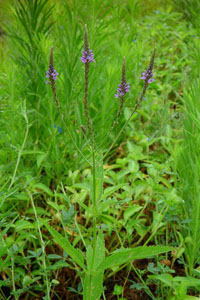 Natural tranquilizer. Promotes sweating. Useful for fevers. Anti-viral. Also used to treat liver disorders, irregular and painful menses, colds, fevers, and flu. Possesses anti-inflammatory and analgesic properties. Possible anti-depressant.
Natural tranquilizer. Promotes sweating. Useful for fevers. Anti-viral. Also used to treat liver disorders, irregular and painful menses, colds, fevers, and flu. Possesses anti-inflammatory and analgesic properties. Possible anti-depressant.
Key Uses: Asthma, bladder, bowels, consumption, convulsions, coughs, bronchitis, fevers, insomnia, stomach, worms.
BONESET (Eupatorium perfoliatum)
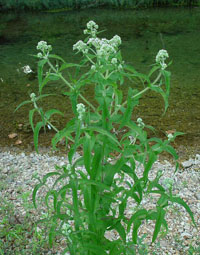 Influenza. Used to reduce fever and relieve body pain and for colds. Relaxant. Taken cold, it is a diuretic and has a mild laxatiave effect. Taken hot, boneset promotes sweating. Useful for bronchial disorders. Aids in removing mucus from the body.
Influenza. Used to reduce fever and relieve body pain and for colds. Relaxant. Taken cold, it is a diuretic and has a mild laxatiave effect. Taken hot, boneset promotes sweating. Useful for bronchial disorders. Aids in removing mucus from the body.
Key Uses: chills, colds, fever prevention, flu, typhoid fever, yellow fever.
BROMELAIN
 Sulfur-containing enzymes that digest protein. Digestive aid. Effective substitute for trypsin or pepsin in cases of pancreatic insufficiency. Excellent anti-inflammatory. Known to increase serum levels of antibiotics. Possible anti-cancer, anti-tumor effects. Useful for arthritis, reduction of swelling especially after surgery. Fluidifies and decreases bronchial secretions. Useful for varicose veins. Augments chemotherapy.
Sulfur-containing enzymes that digest protein. Digestive aid. Effective substitute for trypsin or pepsin in cases of pancreatic insufficiency. Excellent anti-inflammatory. Known to increase serum levels of antibiotics. Possible anti-cancer, anti-tumor effects. Useful for arthritis, reduction of swelling especially after surgery. Fluidifies and decreases bronchial secretions. Useful for varicose veins. Augments chemotherapy.
Key Uses: inflammation, sports injuries, respiratory tract infections, painful menstruation, adjunct in cancer therapy.
BUCHU (Agathosma betulina)
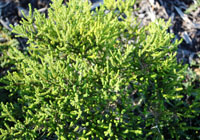 Used for genito-urinary tract. Absorbs excessive uric acid, reduces bladder irritations. Astringent and disinfectant to mucus membranes. Diuretic. Great for inflammation of the urethra and cystitis. Useful in early stages of diabetes. Prostate problems.
Used for genito-urinary tract. Absorbs excessive uric acid, reduces bladder irritations. Astringent and disinfectant to mucus membranes. Diuretic. Great for inflammation of the urethra and cystitis. Useful in early stages of diabetes. Prostate problems.
Key Uses: bladder, kidney problems, nephritis, prostate problems, urethritis.
BUCKTHORN BARK (Rhammus cathartica)
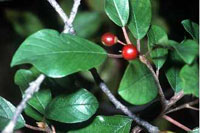 Stimulating effect on bile. Calming effect on gastrointestinal tract. Mild laxative. Safe to use for chronic constipation over an extended period. Good for children. Helpful in ulcerative colitis. Helps relieve liver congestion.
Stimulating effect on bile. Calming effect on gastrointestinal tract. Mild laxative. Safe to use for chronic constipation over an extended period. Good for children. Helpful in ulcerative colitis. Helps relieve liver congestion.
Key Uses: bleeding, bowels, constipation, fevers, gallstones, lead poisoning, liver.
BURDOCK (Arctium lappa)
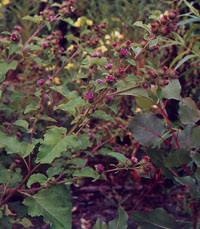 Blood purifier. Reduces inflammation. Promotes kidney function. Nourishes hypothalamus & pituitary glands. Aids in the metabolism of carbohydrates (contains inulin). Abundance of minerals. Excellent for skin diseases. Hypoglycemic. Possible anti-tumor, anti-biotic, anti-fungal properties.
Blood purifier. Reduces inflammation. Promotes kidney function. Nourishes hypothalamus & pituitary glands. Aids in the metabolism of carbohydrates (contains inulin). Abundance of minerals. Excellent for skin diseases. Hypoglycemic. Possible anti-tumor, anti-biotic, anti-fungal properties.
Key Uses: arthritis, blood purifier, eczema, gout, kidney problems, lungs, rheumatism, skin diseases.
BUTCHER’S BROOM (Ruscus aculeatus)
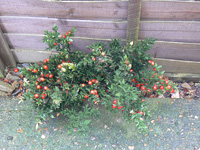 Strengthening effect on vessel walls. Anti-inflammatory. Constricting action on veins. Useful in post-operative conditions. Improves peripheral circulation. Increases circulation to brain, legs and arms. Useful in varicose veins, thrombosis, hemorrhoids and atherosclerosis. Effective for arthritic and rheumatic pains.
Strengthening effect on vessel walls. Anti-inflammatory. Constricting action on veins. Useful in post-operative conditions. Improves peripheral circulation. Increases circulation to brain, legs and arms. Useful in varicose veins, thrombosis, hemorrhoids and atherosclerosis. Effective for arthritic and rheumatic pains.
Key Uses: atherosclerosis, hemorrhoids, thrombosis, varicose veins.
